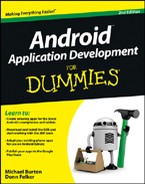Understanding the Android Preferences Framework
One outstanding quality of the Android preferences framework is the simplicity of developing a screen that allows users to modify their preferences. Most of the heavy lifting is done for you by Android because developing a preferences screen is as simple as defining it in the XML located in the res/xml folder of your project. Though these XML files aren’t the same as layout files, there are specific XML definitions that define screens, categories, and actual preferences. Common preferences that are built into the framework include
![]()
EditTextPreference: Stores plain text as a string
![]()
CheckBoxPreference: Stores a Boolean value
![]()
RingtonePreference: Allows the user to store a preferred ringtone from those available on the device
![]()
ListPreference: Allows the user to select a preferred item from a list of items in the dialog box
If the built-in preferences don’t suit your needs, you can create your own preference by deriving it from the base Preference class or DialogPreference. A DialogPreference is the base class for preferences that are dialog-box-based. Tapping one of these preferences opens a dialog box showing the preference controls. Examples of built-in DialogPreferences are EditTextPreference and ListPreference.
Android also provides a PreferenceActivity in which you can load a preferences screen in the same manner as you load a layout for a basic Activity class. This base class allows you to tap into the PreferenceActivity events and perform advanced work, such as setting an EditTextPreference to accept only numbers.
